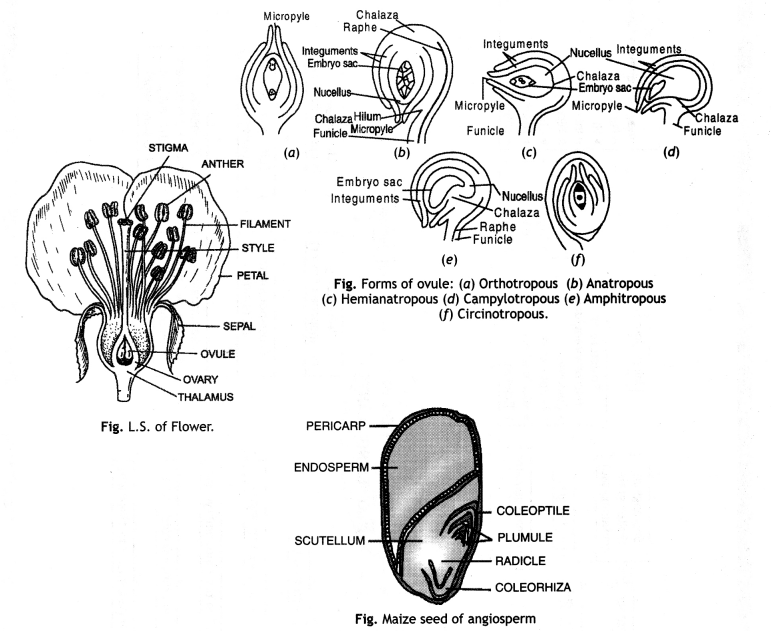Here we are providing Class 12 Biology Important Extra Questions and Answers Chapter 2 Sexual Reproduction in Flowering Plants. Important Questions for Class 12 Biology are the best resource for students which helps in Class 12 board exams.
Class 12 Biology Chapter 2 Important Extra Questions Sexual Reproduction in Flowering Plants
Sexual Reproduction in Flowering Plants Important Extra Questions Very Short Answer Type
Question 1.
Name the component cells of the egg apparatus in an embryo sac?
Answer:
One egg or oosphere and two synergids.
Question 2.
Name the part of gynoecium that determines the compatible nature of pollen grain?
Answer:
Stigma
Question 3.
Name the common function that cotyledons and nucellus perform?
Answer:
Nourishment (embryo by cotyledons and embryo sac by nucellus).
Question 4.
Complete the following flow chart. Pollen grain?
Answer:

A = Generative cell.
Question 5.
Name the structure formed the development of microsporangia?
Answer:
Pollen sac.
Question 6.
Why pollen grains can be preserved as fossils?
Answer:
It is due to the presence of sporopollenin present in exine.
Question 7.
Indicate the stage where meiosis occurs (1, 2 or 3) in the flow chart.

Answer:
1 = Meiosis
Question 8.
State the reason why pollen grains lose their viability when the tapetum in the anther is malfunctioning?
Answer:
As tapetum provides nutrition, the pollen loses its viability due to non-availability of nutrition.
Question 9.
In a case of polyembryony, if an embryo develops from the synergid and another from the nucellus, which is haploid and which is diploid?
Answer:
Synergid embryo is haploid (n) and nucellus embryo is diploid (2n).
Question 10.
Can an unfertilised, apomictic embryo sac give rise to a diploid embryo? If yes, then how?
Answer:
Yes, if the embryo develops from the cells of nucellus or integument, it will be diploid.
Question 11.
Why is an embryo sac diploid in agamospermy?
Answer:
The embryo sac is diploid because it is formed without reductional division.
Question 12.
How do drones develop in honeybees? Name the process.
Answer:
In honeybees, unfertilised eggs develop the drones. They are sterile male. The process is called parthenogenesis.
Question 13.
What is chalaza?
Answer:
Chalaza is the part of nucellus from where integuments arise.
Question 14.
What do you mean by agamospermy?
Answer:
Agamospermy is the formation of embryos by asexual reproductive processes.
Question 15.
What types of pollution occur in Vallisneria? (CBSE Delhi 2019)
Answer:
By water (Hydrophily)
Question 16.
Name a few plants which show viviparous germination?
Answer:
Rhizophora and Sonneratia.
Question 17.
A bilobed, dithecous anther has 100 microspore mother cells per microsporangium. How many male gametophytes this anther can produce? (CBSE 2010)
Answer:
100 × 4 = 400.
Question 18.
An anther with malfunctioning tapetum often fails to produce viable male gametophyte? Give one reason? (CBSE 2010)
Answer:
Tapetum provides nutrition. In the case of malfunctioning tapetum, due to absence of nutrition, it fails to produce viable gametophyte.
Question 19.
How many pollen grains and ovules are likely to be formed in the anther and the ovary of an angiosperm bearing 25 microspore mother cells and 25 megaspore mother cells respectively? (CBSE Sample Paper 2018-19)
Answer:
25 Microspore mother cells will form 100 pollen grains, whereas 25 megaspore mother cells will form 25 ovules respectively.
Question 20.
In the case of polyembryony, an embryo A develops from the synergids and the embryo B develops from the nucellus. State the ploidy of embryo A and B? (CBSE Sample Paper 2018-19)
Answer:
A-Haploid
B-Diploid
Question 21.
Write one advantage and one disadvantage of cleistogamy to flowering plants? (CBSE Delhi 2018C)
Answer:
Advantage:
It maintains pure lines.
Disadvantage:
Only parental characters are preserved.
Question 22.
Why does the zygote begin to divide only after the division of the primary endosperm cell?
Answer:
Division and storage of food in primary endosperm cell forms endosperm which is pre-requirement for developing embryo, which is formed due to division of the zygote.
Sexual Reproduction in Flowering Plants Important Extra Questions Short Answer Type
Question 1.
What is inflorescence?
Answer:
The arrangement and distribution of flowers on a peduncle are called an inflorescence. The axis of the inflorescence is termed peduncle. The flattened peduncle is called the receptacle.
Question 2.
Differentiate between flower and inflorescence?
Answer:
Differences between flower and inflorescence:
| Flowers | Inflorescence |
| 1. It is a modified shoot. | 1. It is an arrangement of flowers on the floral axis. |
| 2. The stalk of flowers is called Pedicet. | 2. The stalk of an inflorescence is called a peduncle. |
Question 3.
List the functions of a flower?
Answer:
Functions of a flower:
- Production of pollen and ovules.
- Aids in pollination.
- Fertilisation.
- Development of seed and fruit.
- Helps in the dispersal of seeds and fruits.
Question 4.
Name the various methods by which anther dehisces?
Answer:
- By Longitudinal intros.
- By Longitudinal dextrose.
- By Apical pores.
- Transverse dehiscence.
Question 5.
Geitonogamy flowering plants are genetically autogamous but functionally cross-pollinated? Justify? (CBSE 2013)
Answer:
- Geitonogamy. It is a transfer of pollen grains from the anther to the stigma of another flower of the same plant.
- Geitonogamy is functionally cross-pollination because it involves a pollinating agent, however genetically it is similar to autogamy since the pollen grains come from the same plant.
Question 6.
List the advantages of self-pollination?
Answer:
Advantages of self-pollination:
- Parental characters can be preserved.
- Self-pollination helps in maintaining pure lines.
- No extra energy required, thus it is an economical process.
- Even if smaller quantities of pollen grains are produced, there is a high chance of pollination.
- Self-pollination avoids wastage of pollen grains.
Question 7.
What are the disadvantages of self¬pollination?
Answer:
Disadvantages of self-pollination:
- There is a gradual decrease in the vigour of the plants produced through self-pollination.
- The yield is decreased.
- The size and number of seeds also go on decreasing generation after generation.
- The plants become susceptible to diseases.
Question 8.
Give the characters of wind-pollinated flowers?
Answer:
Characters of wind-pollinated flowers:
- The size of the flower is very small.
- Bright coloured corolla, nectar glands and fragrance are absent.
- Pollen grains are produced in large quantities.
- Versatile fixation of anthers aids in shaking off pollen grains in the air.
- Pollen grains are dry, smooth and very light, e.g. coconut palm, date palm, Cannabis (Bhang), maize and grasses.
Question 9.
Define ornithophily, chiropterophily and malacophilous?
Answer:
- Ornithophily: Pollination carried out by small birds is called ornithophily, e.g. Australian plants.
- Chiropterophily: It is pollination by bats, e.g. Sausage tree.
- Malacophily: Snails also bring pollination; it is termed malacophilous.
Question 10.
Give an account of the significance of double fertilisation? (CBSE 2010)
Answer:
Significance of double fertilisation:
- After double fertilisation, the development of the endosperm starts when it is required by developing embryo.
- It ensures that nutritive tissue is formed.
- It is an advanced character over gymnosperms where endosperm develops before fertilisation. If fertilisation fails, the energy spent on endosperm development gets wasted; while in angiosperms it develops after double fertilisation.
- Double fertilisation provides the characteristics of male plants as well as the nutritive tissue.
Question 11.
Describe the structure of the fruit?
Answer:
Structure of Fruit: True fruit is enclosed by a wall called the pericarp. When well developed and fleshy, it is differentiated (in most fruits) into three distinct parts-an outer epicarps, middle mesocarp and inner endocarp. In the ripe mango the outer, thin and leathery part (peel), which is usually discarded, is the epicarp.
The sweet, fleshy part that is edible is the mesocarp, and the innermost hard and woody part that encloses the seed is the endocarp. The nature of these three parts, however, varies in different fruits.
In dry fruits, the pericarp is dry, usually papery or woody, and is not distinguishable into the three parts.
Question 12.
(i) Suppose the haploid number of chromosomes in a flowering plant is 12. What will be the ploidy in the cells of integuments, nucellus, antipodals, endosperm and embryo of that plant?
Answer:
| Name of the part | No. of Chromosomes |
| (a) Integument (2n) | 12 × 2 = 24 |
| (b) NuceLtus (2n) | 12 × 2 = 24 |
| (c) Antipodats (in) | 12 × 1 = 12 |
| (d) Endosperm (3n) | 12 × 3 = 36 |
| (e) Embryo (2n) | 12 × 2 = 24 |
(ii) How many haploid cells are present in a mature female gametophyte of a flowering plant? Name them? (CBSE 2010)
Answer:
(a) 6 haploid cells
(b) 3 antipodals, 1 egg cell and 2 synergids.
Question 13.
What do you mean by monosporic development of female gametophyte?
Answer:
In monosporic development as in (Polygonum) the development of embryo sac, only one megaspore situated towards chalazal end remains functional. The remaining three megaspores gradually degenerate and finally disappear. The functional haploid megaspore enlarges in size and, by means of three successive mitotic divisions, gives rise to an eight- nucleate embryo sac.
Question 14.
(i) How are parthenocarpic fruit produced by some plants and apomictic seeds by some? Explain.
Answer:
Parthenocarpy is the production and development of seedless fruits without pollination and fertilisation. Parthenocarpic fruits are normal. Example: Banana, Pineapple, Guava, Grapes, etc.
Apomixis is the mode of reproduction which does not involve the formation of zygote through gametic fusion. Example: Some species of grass.
(ii) When do farmers prefer using apomictic seeds? (CBSE Outside Delhi 2016)
Answer:
Farmers prefer apomictic seeds because they are free from infection and avoid using hybrid seeds which are costly.
Question 15.
Write any two ways by which apomictic seeds may be developed in angiosperms? (CBSE Delhi 2019 C) Answer:
Parthenocarpy. In certain plants, the fruits are formed without the act of fertilisation. Such fruits are called parthenocarpic fruits and the phenomenon is known as parthenocarpy. Parthenocarpic fruits are either seedless or contain empty or non-viable seeds.
In these fruits, the stimulus (seed factor) for fruit growth is provided by the tissue of the ovary wall itself. Seedless varieties of grapes and oranges contain those of the seeded varieties. Most commonly cultivated varieties of banana and pineapple are parthenocarpic. Polyembryony: Formation of more than one embryo in the seed. Onions, groundnuts, mangoes lemons and oranges are some of the examples. Polyembryony is very common among conifers.
Question 16.
You are conducting artificial hybridisation on papaya and potato. Which one of them would require the step of emasculation and why? However, for both, you will use the process of bagging. Justify giving one reason? (CBSE Delhi 2019)
Answer:
- Potato: Potato plant has a bisexual flower, which means it has both male and female reproductive parts in the same flower. And the plant is Monoecious. Hence it needs emasculation to prevent autogamy.
- Papaya: In case of papaya plant, male and female flowers are present on separate plants, that is each plant is either male or female (dioecious). This condition prevents both autogamy and geitonogamy.
So for artificial hybridisation, both will require bagging to prevent contamination of stigma.
Question 17.
Normally one embryo develops in one seed but when an orange seed is squeezed many embryos of different shapes and sizes are seen. Mention how it has happened? (CBSE 2011)
Answer:
In many citrus varieties, some of the nucellar cells surrounding the embryo sac start dividing, protrude into embryo sac and develop into embryos. In such species, each ovule contains many embryos. The occurrence of more than one embryo in a seed is referred to as polyembryony.
Question 18.
A pollen grain in angiosperm at the time of dehiscence from an anther could be 2-celled or 3-celled. Explain. How are the cells placed within the pollen grain when shed at a 2-celled stage? (CBSE 2017)
Answer:
In the majority of angiosperms, pollens are released in a 2-celled stage. However, in other species, the generative cell divides into two male gametes and forms a 3-celled stage. When the pollen grain is shed at the 2-celled stage, it has two unequal cells, a bigger vegetative cell and a smaller generative cell.
Question 19.
Do you think apomixis can be compared with asexual reproduction? Support your answer, giving one reason. How is apomixis beneficial to farmers? Explain. (CBSE Delhi 2018C)
Answer:
A few flowering plants such as some species of Asteraceae and grasses have evolved a special mechanism to produce seeds without fertilisation. This is called apomixis. So apomixis is a form of asexual reproduction.
Production of hybrid seeds is costly; if hybrids with desirable characteristics can be made into apomicts, there is no segregation of characters in the hybrid progeny. The farmer can continue using hybrid seeds year after year and need not to buy new seeds.
Sexual Reproduction in Flowering Plants Important Extra Questions Long Answer Type
Question 1.
Give an account of a structure of typical anther?
Answer:
Structure of anther. A typical angiosperm anther is bilobed with each lobe having two cells or theca, i.e. they are dithecous. Often a longitudinal groove runs lengthwise separating the theca. The bilobed nature of an anther is very distinct in the transverse section of the anther. The anther is a four-sided (tetragonal) structure consisting of four microsporangia located at the corners, two in each lobe.
The microsporangia develop further and become pollen sacs. They extend longitudinally all through the length of an anther and are packed with pollen grains.
Question 2.
Write about the structure of microsporangium? (CBSE 2014)
Answer:
A microsporangium is more often circular in outline and is surrounded by a four-layered wall:
- The outermost layer is the single layer of the epidermis.
- The second layer is endothecium, where cells develop thickenings.
- The middle layer is of 2-4 cells.
- Tapetum, the innermost layer, is of large diploid/polyploid and binucleate or multinucleate cells.
- There are four pollen sacs.
- Each pollen sac has sporogenous tissue.
Question 3.
Describe the development of microspore in angiosperms?
Answer:
Microsporogenesis and formation of pollen grains:
- Every cell of the sporogenous tissue is a potential pollen mother cell (PMC) and can give rise to microspore tetrad/ pollen grains.
- But some of them forego this potential and differentiate into the pollen mother cells of microspore mother cells.
- Each microspore mother cell undergoes meiosis to form a cluster of four haploid cells, called microspore tetrad.
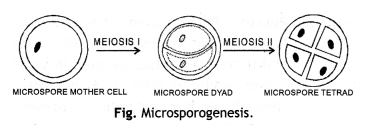
- As the anther matures, the microspores dissociate from the tetrad and develop into pollen grains.
- The tetrad may be tetrahedral, isobilateral, T-shaped, L-shaped and linear.
- The nucleus of the microspore undergoes mitosis to form large vegetative cell and a small spindle¬shaped generative cell that floats in the cytoplasm of the vegetative cell.
Question 4.
What is pollination? Name different types of pollination?
Answer:
Pollination: It is the transfer of pollen grains from the anther to stigma.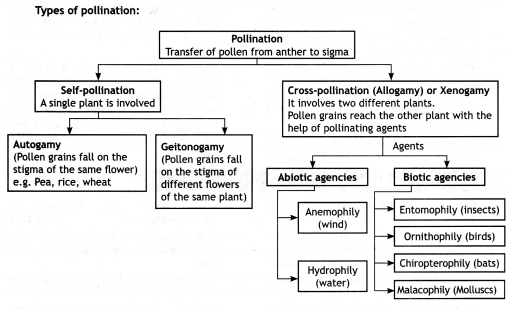
Question 5.
With a neat diagram, explain the 7-celled, 8-nucleate mature female gametophyte? (CBSE Delhi 2014, Outside Delhi 2019)
Answer:
Structure of mature female gametophyte. The female gametophyte is formed from the contents of megaspore. However, it always remains embedded within the membrane of the megaspore. The mature female gametophyte is 7-celled (an egg, two synergids, three antipodals and a central cell).
Out of the seven cells of mature female gametophyte, the egg cell fuses with male gamete to form a zygote, one synergid degenerates and the other synergid directs the pollen tube entry. The central cell fuses with the male gamete to form triploid primary endosperm nucleus and the three antipodals degenerate before or after fertilisation.
They sometimes act as antipodal haustoria:
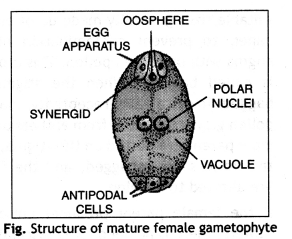
Question 6.
Tabulate the differences between self-pollination and cross-pollination?
Answer:
Differences between self-pollination and cross-pollination:
| Self-pollination | Cross-pollination |
| 1. It is the transference of pollen grains from the anther to the stigma of the same flower. | 1. It is the transference of pollen grains from the anther to the stigma of another flower of another plant. |
| 2. Self-pollination always occurs through touch or wind. | 2. Cross-pollination always occurs through an external agent. |
| 3. Both anthers and stigmas mature simultaneously. | 3. The anthers and stigmas mature at different times. |
| 4. It can occur in closed flowers. | 4. It occurs only when the flowers are open. |
| 5. It gives rise to pure lines. | 5. It gives rise to offspring having variations. |
Question 7.
Briefly explain contrivances for self-pollination?
Answer:
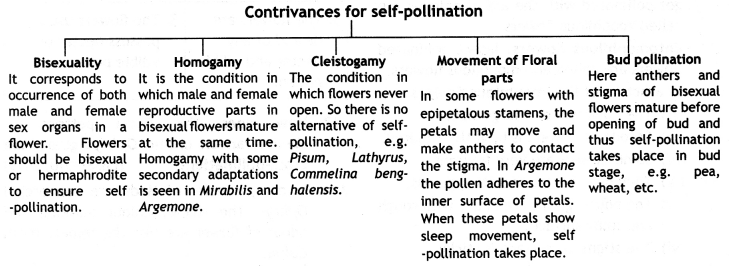
Question 8.
What is bagging technique? How is it useful in plant breeding programmes?
Answer:
Bagging technique: It is a technique used during artificial hybridisation of plant breeding to ensure cross-pollination.
For this removal of anthers from the flower bud before the anther dehisces using a pair of forceps is necessary. This step is referred to as emasculation. Emasculated flowers have to be covered with a bag of suitable size, generally made up of butter paper, to prevent contamination of its stigma with unwanted pollen.
This process is called bagging. When the stigma of bagged flower attains receptivity, mature pollen grains collected from anthers of the male parent are dusted on the stigma, and the flowers are rebagged, and the fruits are allowed to develop.
If the female parent produces unisexual flowers, there is no need for emasculation. The female flower buds are bagged before the flowers open. When the stigma becomes receptive, pollination is carried out using the desired pollen and the flower rebagged.
Advantages of bagging technique:
- It is necessary for cross-breeding for the crop improvement programme.
- Commercially superior varieties can be obtained.
Question 9.
What are zoophily, zoophilous flowers and entomophilous flowers? List the characters of entomophilous flowers?
Answer:
- Zoophily: Pollination by animals is called Zoophily.
- Zoophilous flowers: The flowers which get pollinated with the aid of animals are called zoophilous flowers.
- Entomophilous flowers: Insect pollinated flowers are called entomophilous flowers.
Characters of Entomophilous flowers:
- The flowers are of large size.
- Corolla of flowers is brightly coloured.
- Some flowers are very fragrant.
- They bear nectar-secreting glands.
- The pollen grains are heavy with the rough and spiny surface.
- The stigmatic surface is sticky.
Question 10.
What are the advantages of cross-pollination?
Answer:
Advantages of cross-pollination:
- It increases variability and certain new and useful characters appear in the offsprings.
- Sometimes harmful characters are eliminated.
- It leads to the production of new varieties.
- Several disease-resistant varieties of important crop plants have been produced as a result of cross-pollination.
- It increases the power of adaptation among the offsprings.
- The number of seed production can be increased among useful cereal crops.
Question 11.
Differentiate between anemophilous and entomophilous flower? (CBSE Delhi 2008 (S))
Answer:
Differences between anemophilous and entomophilous flowers:
| Anemophilous flower | Entomophilous flower |
| 1. The flowers are small. | 1. The flowers are either Large or if small the are grouped to form a mass. |
| 2. Flowers are neither brightly coloured nor emit any odour. | 2. The flowers are brightLy coLoured and emit odour. |
| 3. The flowers are devoid of any nectar and edible pollen. | 3. The flowers usually possess nectar or edible pollen. |
Question 12.
How does the floral pattern of Mediterranean orchid Ophrys guarantee cross-pollination? (CBSE 2010, 2019)
Answer:
In many species of Mediterranean orchid Ophrys, the shape, colour marking and odour of flower are like the female moth Colpa.
The Ophrys employs sexual deceit to get pollination done by the Colpa. The male moth matures earlier than the female. It mistakes the Ophrys flower for female and tries to copulate. Thus it pollinates the flower.
Question 13.
Explain the events in the embryo sac during the process of fertilisation?
Answer:
Fertilisation. The fusion of male and female gametes is called fertilisation. The process was first discovered by Strasburger (1884).
Pollen tube enters through the micropyle and releases male gametes. This is called Porogamy. If pollen tube enters through chalaza, it is called chalazogamy and if pollen tube enters through integuments, it is called misogamy. One male gamete (1n) fuses with egg or oosphere to form oospore (2n) and second male gamete fuses with secondary nucleus (2n) to form the primary endosperm nucleus (3n).
In angiosperms where both male gametes are functional and bring about fertilisation of oosphere and secondary nucleus to form oospore and primary endosperm nucleus, is called double fertilisation.
Question 14.
What do you understand by double fertilisation? (CBSE Sample Paper) (CBSE Delhi (C) 2008)
Or
Where does triple fusion take place in a flowering plant? (CBSE 2010)
Answer:
In angiosperms both the male gametes are functional. Double fertilisation is a process in which the egg nucleus and secondary nucleus are fertilized at one time by the male gametic nuclei. The fusion of one male gamete nucleus (1n) with egg or oosphere (1n) is called syngamy and results in the formation of oospore (2n).
The second male gamete fuses with the secondary nucleus; it is called triple fusion which results in the formation of the primary endosperm nucleus (3n). Thus it takes place in the embryo sac. It was first discovered by Nawaschin (1898).
Question 15.
What is the fate of floral parts after fertilisation?
Answer:
After fertilisation, the transformation of parts of the flower is as follows:
| Before fertilization | After fertilization |
| 1. Calyx, Corolla, Androecium, Style, Stigma | Wither off |
| 2. Ovary | Fruit |
| 3. Ovary wall | Pericarp |
| 4. Ovule | Seed |
| 5. Integuments | Seed coats |
| 6. Outer integument | Testa |
| 7. Inner integument | Teg men |
| 8. Micropyle | Macrophyte |
| 9. Funicte | Stalk of seed |
| 10. Nucellus (persistent) | Pensperm |
| 11. Egg cell | Zygote (oospore) |
| 12. Synergids | Disintegrate and disappear |
Question 16.
Write an account of various types of fruits?
Answer:
Types of fruits:
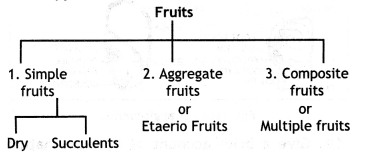
- Simple fruit: Fruits develop from a single ovary.
- Aggregate fruit: Develops from the polycarpellary, apocarpous ovary. Composite fruit. Which develops from the inflorescence.
- Dry fruit: When mesocarp, epicarp and endocarp all are hard.
- Succulent fruit: When mesocarp is pulpy.
Question 17.
Mention two strategies evolved by flowers to prevent self-pollination? (CBSE 2014)
Answer:
Contrivances favouring cross-pollination In many plants there are devices which completely or partially prevent self-pollination and encourage cross¬pollination.
- Unisexuality: The flowers are unisexual, i. e. stamens and carpels occur in different flowers. They may be present on the same plant, e.g. in maize or on different plants, e.g. in Papaya. The first condition is called monoecious and second is called dioecious.
- Dichogamy: When stamens and carpels of bisexual flowers mature at different times, it is called dichogamy. If stamens mature first it is called a protandrous condition, or if carpels mature first it is called protogynous condition.
Question 18.
Draw a monocot endospermic seed? (CBSE 2012, 2019)
Answer:
Seeds of angiosperm:
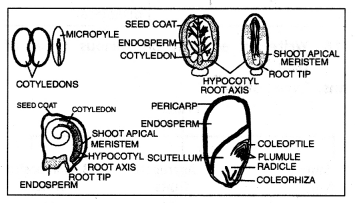
Seeds of angiosperm.
Question 19.
Give a brief account of post-pollination events? (CBSE Delhi 2016)
Answer:
Post-pollination events:
- The fusion of male and female gametes is called fertilisation. The process was first discovered by Strasburger (1884).
- Pollen tube enters through the micropyle and releases male gametes. This is called Porogamy. If pollen tube enters through chalaza, it is called chalazogamy and if pollen tube enters through integuments, it is called misogamy.
- One male gamete fuses with egg or oosphere to form oospore (2n) and second male gamete fuses with secondary nucleus (2n) to form the primary endosperm nucleus (3n).
- In angiosperms where both male gametes are functional and bring about fertilisation of oosphere and secondary nucleus to form oospore and primary endosperm nucleus, is called double fertilisation.
- Development of endosperm from the primary endosperm nucleus.
- Development of embryo from a zygote,
- Development of seed from the ovule.
Question 20.
(i) Can a plant flowering in Mumbai be pollinated by pollen grains of the same species growing in New Delhi? Provide explanations for your answer.
Answer:
Yes, it is possible by artificial hybridisation in which pollen grains of one flower is introduced artificially on the stigma of another flower. But there should not be self-incompatibility.
However, it is important to make sure that only the desired pollen grains are used for pollination and the stigma is protected from contamination (from unwanted pollen). This is achieved by emasculation and bagging techniques.
(ii) Draw the diagram of a pistil where pollination has successfully occurred. Label the parts involved in reaching the male gametes to its desired destination. (CBSE 2017)
Answer:
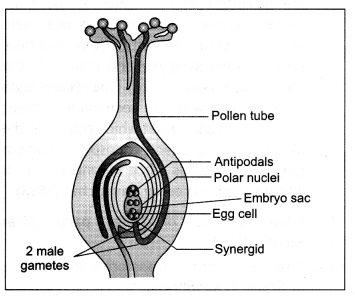
Question 21.
Differentiate between parthenocarpy and parthenogenesis. Give one example of each? (CBSE2018)
Answer:
Parthenocarpy is the process which produces fruits from unfertilised ovules in plants. Unfertilised ovules develop into fruits prior to fertilisation. Such fruits do not contain seeds.
However, parthenogenesis can be described as a process in which unfertilised ovum develops into an individual (virgin birth) without fertilisation. Therefore, it can be considered a method of asexual reproduction.
Such a type of reproduction is commonly shown by some invertebrates and lower plants, e.%. rotters, honeybees and some lizards and birds (turkey), etc.
Another key difference between parthenogenesis and parthenocarpy is parthenogenesis is shown by animals and plants while parthenocarpy is shown by plants only.
Question 22.
The embryo sac in female gametophyte is seven celled and eight nucleated structure. Justify the statement with the help of a labelled diagram? (CBSE Sample Paper 2018-19)
Answer:
A typical embryo sac has three cells that are grouped together at the micropylar end and constitute the egg apparatus. The egg apparatus, in turn, consists of two synergids and one egg cell.
Three cells are at the chalazal end and are cast the antipodals. The Large central cell has two polar nuclei.
Thus, a typical angiosperm embryo sac at maturity is 7-celled and 8-nucLeated.
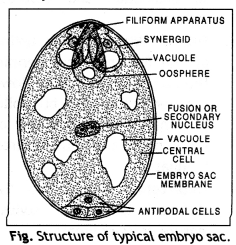
Question 23.
List the changes that occur when an ovule matures into a seed? (CBSE Sample Paper 2018-19)
Answer:
- Integuments of ovules harden and become tough protective seed coats.
- The micropyle remains as a small pore in the seed coat.
- As the seed matures, its water content is reduced.
- Seeds become relatively dry. It has 10-15 percent moisture by mass.
- The general metabolic activity of the embryo slows down.
- The embryo may enter a state of inactivity called dormancy.
Question 24.
What are the various adaptations or contrivances met within angiosperms flowers which favour cross-pollination?
Answer:
Contrivances favouring cross-pollination: In many plants, there are devices which completely or partially prevent self-pollination and encourage cross-pollination.
1. Unisexuality: The flowers are unisexual, i.e. stamens and carpels occur in different flowers. They may be present on the same plant, e.g. in Three cells are at the chalazal end and are called the antipodals. The large central cell has two polar nuclei.
Thus, a typical angiosperm embryo sac at maturity is 7-celled and 8-nucleated.
Structure of typical embryo sac.
maize or on different plants e.g. in Papaya. The first condition is called monoecious and second is called dioecious. In monoecious plants, both self-and cross-pollination can occur but mostly there is cross-pollination as sex organs mature at different times. In dioecious only cross-pollination occurs.
2. Dichogamy: When stamens and carpels of bisexual flowers mature at different times it is called dichogamy.
If stamens mature first, it is called a protandrous condition, or if carpels mature first, it is called protogynous condition. Dichogamy prevents self-pollination and ensures cross-pollination.
3. Self-sterility: In orchids, pollen grains of one flower does not germinate on the stigma of the same flower. This is called self-sterility but pollen grain germinates on the stigma of some other plant and thus ensures cross pollination.
4. Heterostyly: In primrose, there are different lengths of styles which ensure cross-pollination.
5. Herkogamy (Herko-barrier): In bisexual flowers, e.g. in Salvia and pea, peculiarities of petals ensure insect pollination, thus aids in cross-pollination.
Question 25.
With a neat labelled diagram, describe the parts of a typical angiosperm ovule? (CBSE Delhi 2014)
Answer:
Structure of ovule. Each ovule consists of nucellus surrounded by two integuments and a stalk or funiculus.
- Funiculus is a stalk-like structure by which ovule is attached to the placenta.
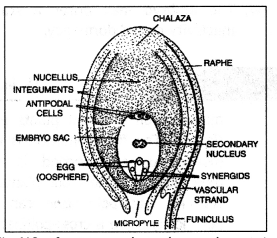
v.s. of the mature ovule to show various parts. - Hilum: It is the point of attachment of the body of the ovule with the funiculus.
- Raphe: It is the longitudinal ridge formed by the lengthwise fusion of funiculus with the body of ovule in a typical anatropous ovule.
- Nucellus: It is a mass of diploid cell called megasporangium. It provides nourishment in the development of embryo sac.
- Embryo sac: It is the female gametophyte which contains the egg apparatus.
- Integuments from seed coats, i.e. testa and tegmen.
- Micropyle: It is a small opening which is left by the integument in the ovule for the passage of pollen tube into the ovule.
- Chalaza: The basal region of the ovule where the funiculus is attached is termed chalaza.
Question 26.
Describe the structure of typical embryo sac and the functions performed by its various constituents?
Or
Draw a schematic labelled diagram of fertilized embryo sac of angiosperm? (CBSE 2008, 2012, 2013)
Answer:
In the mature ovule, within the nucellus towards the micropylar end is a large cell called embryo sac. It is also called a female gametophyte. It contains cytoplasm, two free nuclei and six small cells. Two free nuclei fuse to form a secondary nucleus.
Out of these, three cells constitute egg apparatus (two synergids and one oosphere or egg cell). The other three cells lie at the chalazal end of embryo sac and are called antipodal cells. They are small and enclosed in thin cell walls.
In egg apparatus, egg fuses with male gamete to form zygote or oospore which later gives rise to the embryo. Synergids help in fertilisation. Secondary nucleus fuses with the second male gamete to form primary endosperm nucleus which later on forms endosperm.
The three antipodal cells degenerate:
A typical embryo sac has three cells that are grouped together at the micropylar end and constitute the egg apparatus. The egg apparatus, in turn, consists of two synergids and one egg cell.
Three ceLLs are at the chaLazaL end and are cast the antipodals. The Large centraL ceLL has two poLar nucLei.
Thus, a typical angiosperm embryo sac at maturity is 7-celLed and 8-nucLeated.

Question 27.
Describe the structure of typical microspore (pollen grain)?
Or
Name the organic material of exine and intine of an angiospermous pollen grain. Mention their role. (CBSE Delhi 2014) Answer:
Structure of pollen grains:
- Pollen grains are normally spherical in outline.
- Each pollen grain has a prominent two-layered wall.
- The outer layer is called exine and the inner layer is called intine.
- The exine is hard and made of sporopollenin. It shows a variety of architecture as per the characteristic of each species.
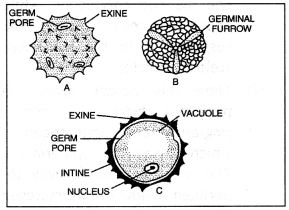
- Intine is thin and it is made of cellulose and pectin.
- At certain places, exine is either absent or very thin and such places are called germ pores. In monocots, there are germinal furrows.
- A mature pollen grain has two cells-a vegetative cells and a generative cell.
- The vegetative cell is larger, has abundant reserve food and a large irregular-shaped nucleus.
- The generative cell is small, spindle¬shaped and floats in the cytoplasm of the vegetative cell.
Question 28.
Draw a well-labelled diagram of T.S. of the anther? (CBSE Sample paper 2009)
Or
Draw a labelled schematic diagram of the transverse section of a mature anther of an angiosperm plant. (CBSE Delhi 2013)
Answer:
T. S. of anther
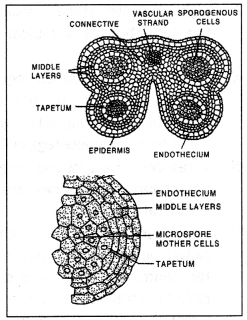
(A) Transverse section of a tetra eusporangiate anther to show its various tissue;
(B) Enlarged view of one microsporangium showing wall layers.
Question 29.
Explain the development of the female gametophyte. Illustrate the answer with suitable diagrams? (CBSE Delhi 2019, Outside Delhi 2019)
Answer:
Development of female gametophyte:
- The functional megaspore is the first cell of the female gametophyte of angiosperms.
- It enlarges to form the female gametophyte, also called embryo sac.
- Its nucleus undergoes a mitotic division and the two nuclei move to the opposite poles, forming the 2-nucleate embryo sac.
- Two successive mitotic divisions in each of these two nuclei result in the formation of an 8-nucleate embryo sac.
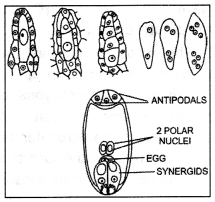
Fig. Development of embryo sac. - Cell wall formation starts at the eight-nucleate stage, resulting in the formation of a typical female gametophyte.
- Three cells are grouped together at the micropylar end to form the egg apparatus, consisting of two synergids and a female gamete/egg cell.
- Three cells are grouped together at the chalazal end. They are called antipodal cells.
- The remaining two nuclei are called polar nuclei. They move to the centre of the embryo sac (now called a central cell) and fuse to form a diploid secondary nucleus.
- Thus, a typical angiosperm embryo sac is 8-nucleate and 7-celled.
Question 30.
Show the germination of pollen grain with diagrams only? (CBSE 2011, 2019 C)
Answer:
Germination of Pollen Grain:
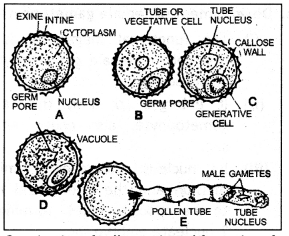
Germination of pollen grain and formation of male gametophyte in an angiosperm.
Question 31.
What do you mean by the development of the embryo? Support the answer with a diagram? (CBSE Delhi 2014)
Answer:
Development of embryo.
1. The zygote or oospore divides by a transverse wall into an upper suspensor cell and lowers embryonal cell.
2. The suspensor cell which lies towards the micropylar end divides by transverse divisions to constitute 7-10 cells called suspensor.
3. The upper cell of the suspensor filament towards the micropylar end is called a haustorial cell, whereas the cell lying above the embryo cell is called hypophysis.
4. The haustorial cell enlarges in size and attaches the suspensor to the tip of embryo sac.
5. The embryonal cell divides by second longitudinal division at a right angle to the first and then by transverse division to form an octant or eight- celled embryo.
6. Out of these eight cells, the lower four cells of octant away from the suspensor give rise to the plumule and the two cotyledons, while the above four cells of octant near the suspensor from the hypocotyl and stele of the radicle.
7. Then this octant divides by a periclinal division to form outer single-layered dermatogen from which arises the epidermis layer. The inner cells further divide to form periblem below the dermatogen and the central plerome.
8. The periblem forms the cortex while the plerome gives stele of the embryo.
9. The lowermost cell of suspensor, which is lying just above the octant cells is known as hypophysis. The hypophysis divides to give rise to the dermatogen and periblem of the radicle.
10. A fully developed embryo of dicotyledons has an embryonal axis differentiated into plumule, two cotyledons and radicle.
11. In the beginning, the embryo is globular. When two cotyledons differentiate from the sides with faint plumule in the centre, the embryo becomes heart¬shaped. Then the embryo undergoes rest and ovule is transformed into the seed.
Monocot embryo: Unlike the dicots where the embryonal mass is formed of eight cells, the anterior cells forming the plumule and the cotyledons, and the posterior forming hypocotyl, the development is much variable in monocots, i.e. grass family. In some cases, suspensor does not develop at all. Only one cotyledon appears in monocots as a terminal structure. The plumule always appears laterally from it.
Question 32.
Draw the stages of development of the embryo in a dicot angiosperm?
Answer:
Stages of embryo development in a dicot angiosperm:
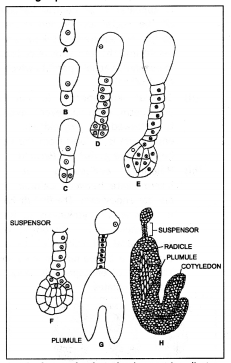
Stages of embryo development in a dicot angiosperm.
Question 33.
Explain the role of tapetum in the pollen grain wall formation?
Answer:
Role of tapetum in pollen grain wall formation. During microsporogenesis, the cells of tapetum provide various enzymes, hormones, amino acids and other nutritive materials to the dividing microsporocytes.
The main functions of tapetum are:
- Transportation of nutrients into anther locule at the time of meiosis in spore mother cells.
- Secretion of enzymes and hormones.
- Production of Ubisch bodies which are coated with sporopollenin to cause thickening of the exine.
- Secretion of any oily material (Pollenkitt) outside of mature pollen.
- Secretion of special proteins for pollen to recognise compatibility.
Question 34.
Describe in brief the various special modes of reproduction? Mention their economic significance?
Answer:
Special modes of reproduction:
1. Apomixis (Agamospermy): It is a modified form of reproduction in which seeds are formed without fusion of gametes. It includes the process whereby a diploid cell of nucellus develops into an embryo, giving a diploid seed with a genetic constitution identical to the parent. The organism that reproduces by apomixis is called apomict.
2. Parthenocarpy: In certain plants, the fruits are formed without the act of fertilisation. Such fruits are called parthenocarpic fruits and the phenomenon is known as parthenocarpy. Parthenocarpic fruits are either seedless or contain empty or non-viable seeds. In these fruits, the stimulus (“seed factor”) for fruit growth is provided by the tissue of the ovary wall itself. Seedless varieties of grapes and oranges contain those of the seeded varieties. Most commonly cultivated varieties of banana and pineapple are parthenocarpic.
3. Polyembryony: It is the formation of more than one embryo in the seed. Onion, groundnut, mango, lemon and oranges are some of the examples. Polyembryony is very common among conifers.
4. Sporophytic budding: It may occur in the nucellus and integuments, resulting in the development of an embryo. Examples: Orange, mango, onion, etc.
5. Micropropagation: In this method, tissue and organ culture is utilised. Tissue or organs grow on suitable medium containing hormones. Tissue proliferates to form a callus. From this callus, arise new plantlets. Each plantlet, when transferred to pot or soil, produces a new plant. Thus by this method, an indefinite number of plants can be raised from a small mass of partial tissue.
6. Plant tissue culture. It also helps in propagating plants to a great extent.
Question 35.
Fertilisation is essential for the production of seed, but in some angiosperms, seeds develop without fertilisation?
(i) Give an example of an angiosperm that produces seeds without fertilisation. Name the process.
Answer:
(a) Species of Asteraceae and grass.
(b) Process of formation of seeds without fertilization is called apomixis.
(if) Explain the two ways by which seeds develop without fertilisation. (CBSE 2009)
Answer:
Apomixis is a form of asexual reproduction that mimics sexual reproduction:
(a) The diploid egg cell is formed without reduction division and develop into an embryo without fertilisation.
(b) In some varieties of citrus and mango, some of the nucellar cells surrounding the embryo sac start dividing, produce embryo sac and develop into embryos. In such species, each ovule contains many embryones. Such a process is called polyembryony.
Question 36.
Write a note on the development of endosperm. Mention the types with examples?
Answer:
Development of endosperm: Endosperm develops after double fertilisation in angiosperms. It is triploid and develops from the primary endosperm nucleus.
In angiosperms three types of endosperm development are observed:
1. Nuclear endosperm. In nuclear endosperm development, the nucleus divides by free nuclear division, there is the appearance of the central vacuole, all the nuclei are pushed towards periphery then starts cytokinesis and results in the formation of cells but in coconut, vacuole persists which is filled with fluid.
2. Cellular endosperm. In cellular endosperm, each and every division is followed by cytokinesis, so endosperm is cellular from the very beginning, e.g. Datura, Petunia.
3. Helobial endosperm. It is intermediate between cellular and nuclear endosperm. The first division is followed by cytokinesis to form two unequal cells, micropylar cell and chalazal cell. Further divisions in each cell are free nuclear divisions. This type of endosperm is found in order Helobiales.
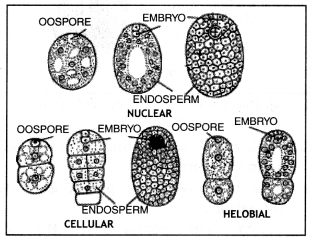
Types of endosperm development.
Question 37.
What are the advantages of seeds to plants and mankind? (CBSE Delhi 2014)
Answer:
1. Advantages of seeds to plants:
(a) Seeds have better adaptive strategies for dispersal to new habitats for better survival.
(b) Seeds have reserve food materials to nourish the seedlings during seed germination.
(c) The hard seed coat provides protection to the young embryo.
(d) Since seeds are formed after sexual reproduction, they show genetic recombinations leading to variations.
(e) Since seed formation does not depend on water (for fertilisation), their formation is more certain and they are the units of multiplication and continuity of the species.
2. Advantages of seeds to mankind:
(a) Seeds are stored and used as food throughout the year.
(b) Seeds are also used to raise the crop in the favourable seasons depending on their viability.
Question 38.
(i) Draw a diagrammatic sketch of a transverse section of an anther of an angiosperm. Label its different walls and the tissue forming microspore mother cells?
Answer:
T. S. of anther

(A) Transverse section of a tetra eusporangiate anther to show its various tissue;
(B) Enlarged view of one microsporangium showing wall layers.
(ii) Describe the process of microsporogenesis up to the formation of a microspore?
Answer:
Microsporogenesis and formation of pollen grains:
- Every cell of the sporogenous tissue is a potential pollen mother cell (PMC) and can give rise to microspore tetrad/ pollen grains.
- But some of them forego this potential and differentiate into the pollen mother cells of microspore mother cells.
- Each microspore mother cell undergoes meiosis to form a cluster of four haploid cells, called microspore tetrad.

- As the anther matures, the microspores dissociate from the tetrad and develop into pollen grains.
- The tetrad may be tetrahedral, isobilateral, T-shaped, L-shaped and linear.
- The nucleus of the microspore undergoes mitosis to form large vegetative cell and a small spindle¬shaped generative cell that floats in the cytoplasm of the vegetative cell.
(iii) Write the function of ‘germ pore’ in a pollen grain of an angiosperm? (CBSE Delhi 2018C)
Answer:
Germ pores allow the germinating of pollen tube with contents of the male gametes and vegetative cell to come out of the pollen grains.
Question 39.
(i) When a seed of orange is squeezed, many embryos instead of one are observed. Explain how it is possible?
Answer:
When a seed of orange is squeezed, many embryos instead of one are observed. It is due to polyembryony. Polyembryony is the occurrence of more than one embryo in a seed.
The nucellar cells, synergid or integument cells develop into a number of embryos of different sizes in orange.
Sometimes the formation of more than one egg in an embryo sac can lead to polyembryony.
(ii) Are these embryos genetically similar or different? Comment.
Answer:
These embryos are genetically similar because in such embryos parental characters are maintained. In this process, there is no segregation of characters in the offspring.
Question 40.
(i) Describe any two devices in a flowering plant which prevent both autogamy and geitonogamy?
(ii) Explain the events up to double fertilisation after the pollen tube enters one of the synergids in an ovule of an angiosperm? (CBSE 2018)
Or
Explain the post-pollination events up to double fertilization that occurs in angiosperm. (CBSE 2019 (c))
Answer:
(i) Autogamy: It is the transfer of pollen grains from the anther to the stigma of the same flower.
Geitonogamy: It is the transfer of pollen grains from the anther to the stigma of another flower of the same plant.
Two devices that prevent both autogamy and geitonogamy are:
(a) Self-incompatibility: This is a genetic mechanism which prevents self pollen from fertilising the ovules by inhibiting pollen germination or growth of pollen tube in the pistil.
(b) Dioecious plants: Male and female flowers are present on different plants.
(ii) The events seen after the pollen tube enters one of the synergids in an ovule is as follows:
(a) After reaching the ovary, pollen tube enters the ovule through the micropyle and thus enters one of the synergids through filiform apparatus.
(b) After entering one of the synergids, the pollen tube releases the two male gametes into the cytoplasm of the synergid.
(c) One of the male gametes moves towards the egg cell and fuses with its nucleus and results in the formation of the zygote (diploid cell). This is called syngamy.
(d) The other male gamete moves towards the two polar nuclei present in the central cell and fuses to form triploid primary endosperm nucleus (PEN) i.e., there is a fusion of three haploid nuclei and hence termed as triple fusion.
(e) Two types of fusions-syngamy and triple fusion-take place in an embryo sac. Hence the phenomenon is termed double fertilisation.
(f) After fertilisation, the primary endosperm nucleus becomes the primary endosperm cell (PEC) and develops into endosperm while zygote develops into an embryo.
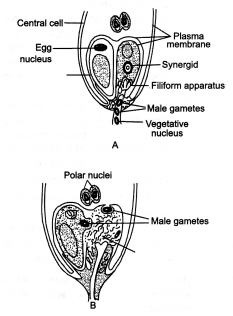
Fig. (A) EnLarged view of an egg apparatus showing entry of poLLen tube into a synergy, (B) Discharge of male gametes into a synergid and the movements of the sperms, one Into the egg and the other Into the centraL celL.
Very Important Figures
